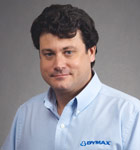
In the world of project, portfolio, and program management, failure has long been the only constant. As a well-seasoned, detail-oriented cost analyst, this fact has always astounded Neil F. Albert. Having worked on a broad spectrum of complex programs, the CEO of MCR, LLC believes he can be part of the solution by shining a light on integrated program-management principles. Profile recently sat down with the 2010 International Society of Parametric Analysts’ Lifetime Achievement Award recipient to discuss his views on the evolution of program management in an increasingly global marketplace.
What was your role in the management buyout of MCR from AT&T? I came on board in 1988 with the responsibility of starting MCR’s Boston office. At the time, the company’s founder, Dr. Gerald McNichols, wanted to expand MCR’s presence at Hanscom Air Force Base, and he convinced me it would be a good opportunity. Over time, I became the vice president for the eastern region of MCR. In the late 1990s, MCR was sold to General Research Corp., International (GRCI), which was in turn sold to AT&T Government Solutions. It was during this time that I was given leadership responsibilities for the entire company. After about five years in this arrangement, we convinced AT&T to sell MCR because most of our work was classified as small business and AT&T was not a small business; there was also a conflict between selling “product” versus “services.” In 2004, we bought ourselves out as a mix of an equity investor and the management team.
Over the years
1983—Serves as Director of Cost Estimating and Analysis at Textron Defense Systems
1988—Joins MCR as a director in charge of establishing the firm’s Boston office
2004—Completes the management buyout of MCR from AT&T and becomes president and CEO
2007—Receives Department of Defense’s Medal for Exceptional Public Service for efforts in support of the Defense Business Board
2003 and 2010—Receives two lifetime-achievement awards from the Society of Cost Estimating and Analysis and the International Society of Parametric Analysts
Considering all the changes, how did MCR’s focus evolve? From the beginning, MCR focused on supporting government programs with cost analysis including research, modeling, and estimating. However, around the time Dr. McNichols sold the company, contracted cost analysis had seemed to reach a plateau. With this in mind, I looked to broaden our focus to include the vast envelope of program management. In 2003, we introduced our focus on integrated program management defined in terms of a program’s life cycle. We recognized a real opportunity to help plan the program baseline in terms of cost and schedule, manage the program once on contract, and then solve problems so clients could take the right road to reach the end result.
Our traditional market of cost analysis has remained very steady, but as we have moved into the program-management field, we have been able to adapt to what is happening in the world today, where cost and schedule complications regularly force program cancellations.
What are your key accomplishments? Convincing AT&T to allow us to leave their structure was one of MCR’s most significant and crucial accomplishments under my watch. I served as Moses for our company—asking AT&T’s senior management to “let my people go.” This allowed us to eliminate the business-model conflict that was hampering our ability to grow.
Another big step for us came when, for the first time, we decided to buy a critical contract. We did this by buying the CAPS (Consolidated Acquisition Professional Services) contract at Wright-Patterson Air Force Base from Innovative Logistics Techniques, Inc. This helped bring our program-management focus to fruition. It was no longer just a twinkle in my eye—we were truly becoming a relevant company in the program-management marketplace.
Any lessons learned from this growth spurt? There are major differences in managing a company that does $20 million in revenue to one that now does $120 million in revenue. You need to remain focused with an understanding of your goals and how you will achieve them—which, in our case, is the vision of integrated program management and how we can help struggling program managers with our knowledge, experience, and tools. We have also learned to be adaptable to circumstances and always have the right people in place to meet project needs.
by the numbers
34
years in the
industry
9
positions held
5
past employers
635
employees under
his wing
5
awards received
What are the next steps for MCR? As we build on the integrated-program-management theme, we are constantly looking for opportunities to grow both organically and through acquisitions. The global market will continue to be an area of interest as well. We recently received two contracts supporting NATO, which will be stepping-stones for us. We have worked with South Korea, Great Britain, Japan, and the European Space Agency. Our wealth of experience can help a lot of other countries facing similar program issues.
Looking ahead, the biggest challenge will continue to be the customer dynamic (insourcing, debt reductions, etc.). We need to continue to provide a value-added service that focuses on leadership needs in terms of advice and support. This is what we are all about—helping encourage new efficiencies.

